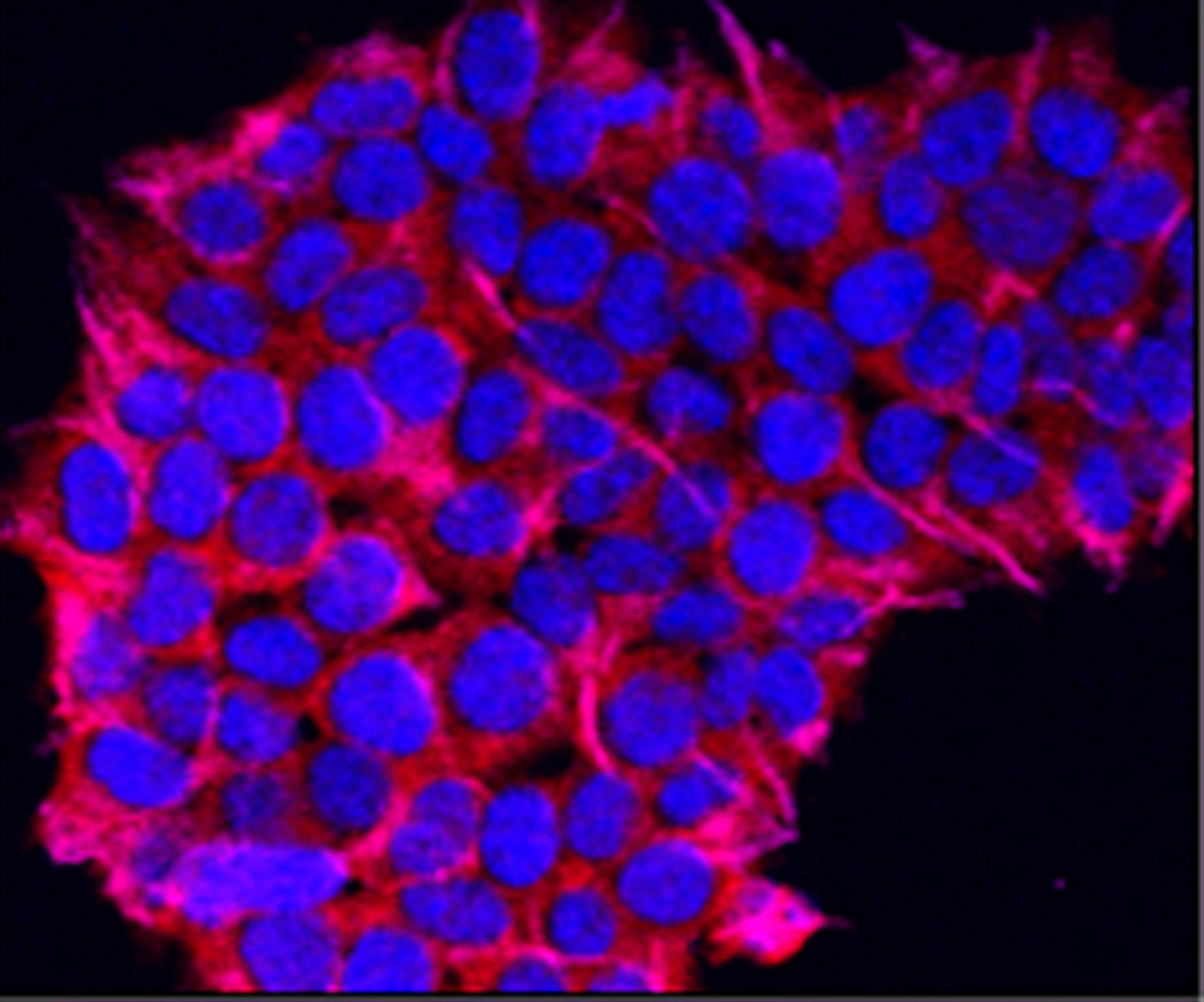创新背景
大多数哺乳动物细胞的细胞核内都有超过6英尺长的DNA,如果把它们拉伸成一条线的话。这种遗传物质决定了细胞的命运,如果错位或受损,就会导致疾病。先前的研究表明,DNA倾向于在细胞核的某些区域聚集。然而,这种位置如何影响DNA功能仍不清楚。
创新过程
这项新技术被称为CRISPR-基因组组织或简称为CRISPR- go,它使用一种改良的CRISPR蛋白在三维空间中重组基因组。如果CRISPR像分子剪刀,那么CRISPR- go就像分子镊子,抓住基因组的特定片段,然后把它们放到细胞核的新位置。但这不仅仅是物理上的重新安置:取代基因元素可以改变它们的功能。这项研究揭示了基因组在细胞核中的空间组织如何支配整个细胞的功能。

在原理证明研究中,祁使用CRISPR-GO研究了细胞核的三个不同的子区域,测试了一个重要的假设:基因和其他遗传元素在细胞核的不同区域表现不同吗?
到目前为止,他们的数据显示,细胞核中特定的隔室和一些自由漂浮的蛋白质体可以影响重新定位的DNA的功能。根据遗传物质的位置,一些核区域会抑制基因表达,一些核区域会加速端粒的生长,进而促进细胞分裂。一个蛋白质体甚至可能具有抑制肿瘤形成的能力。
揭开基因组物理细节的神秘面纱已经被证明是一项乏味的任务,但现有的一些技术可以让科学家窥视细胞,看看它们的内脏是如何物理组织的。现在缺少的是一种可以干预这个组织的方法。CRISPR-GO是第一个为研究人员提供这样做的手段。
通过解除CRISPR-Cas9的“切割”机制,编辑工具变得更像是一个传递系统,祁利用该系统通过可编程的引导RNA将小段DNA传递到细胞核中的新位置。
CRISPR-GO有三个基本部分。首先,这就是戚建平所说的你想重新定位的基因目标的“地址”——一段DNA,它的目标是与互补的结合RNA链。然后,你需要目的地的地址——你想把染色质移动到核隔间中DNA的特定部分。最后是“桥”,在这种情况下,它是一种催化剂,激发目标DNA凝结到细胞核中的新家。
他描述了核心隔间的功能,就像房子的空间一样。在家里的每个房间,你做不同的事情——在厨房,你做饭;在卧室里,你睡觉。同样的概念也适用于细胞核。细胞核中有多个隔室,它们在维持细胞整体功能方面都起着特定的作用。祁和他的实验室研究了细胞核的三个不同区域,测试他们是否可以以某种方式改变染色质的功能,这取决于他们移动染色质的位置。
通过使用CRISPR-GO,研究人员观察到,基因迁移到细胞核中被称为卡哈尔体(Cajal body)的一部分,这是一个无形的、有点神秘的蛋白质和RNA团,停止了蛋白质的表达。

当祁使用CRISPR-GO将染色体端粒(与寿命相关的染色体分子帽)的DNA从细胞核中部移动到边缘时,端粒停止生长,停止细胞周期,降低细胞活力。然而,当端粒靠近卡哈尔体时,情况则相反:它们生长了,并在此过程中提高了细胞活力。
第三个应用使用CRISPR-GO形成早幼粒细胞白血病体。这种蛋白质团被认为可以抑制肿瘤前基因。通过将其定位在细胞核中致癌基因的旁边,祁教授计划测试它是否有助于抑制肿瘤的形成。
创新价值
斯坦福大学的研究人员重新设计了CRISPR-Cas9基因编辑技术,以在三维空间中操纵基因组,使他们能够将基因片段运送到细胞核的不同位置。
创新关键点
通过解除CRISPR-Cas9的“切割”机制,编辑工具变得更像是一个传递系统,研究人员利用该系统通过可编程的引导RNA将小段DNA传递到细胞核中的新位置。
Using new gene editing technology, DNA can be located, moved and relocated
This new technology is called CRISPR genome organization or CRISPR go for short. It uses an improved CRISPR protein to recombine the genome in three-dimensional space. If CRISPR is like molecular scissors, CRISPR - go is like molecular tweezers, grabbing specific segments of the genome and then placing them in new positions in the nucleus. But this is not just a physical relocation: replacing genetic elements can change their function. This study reveals how the spatial organization of the genome in the nucleus dominates the function of the whole cell.
In the proof of principle study, Qi used crispr-go to study three different sub regions of the nucleus and tested an important hypothesis: do genes and other genetic elements behave differently in different regions of the nucleus?
So far, their data show that specific compartments and some free floating protein bodies in the nucleus can affect the function of the relocated DNA. According to the location of genetic material, some nuclear regions will inhibit gene expression, and some nuclear regions will accelerate the growth of telomeres, thus promoting cell division. A protein body may even have the ability to inhibit tumor formation.
Unveiling the physical details of the genome has proved to be a tedious task, but some existing technologies allow scientists to peek into cells to see how their internal organs are physically organized. What is missing is a way to intervene in this organization. Crispr-go is the first tool to provide researchers with the means to do so.
By releasing the "cleavage" mechanism of crispr-cas9, the editing tool becomes more like a delivery system. Qi Li uses this system to deliver small pieces of DNA to new positions in the nucleus through programmable guide RNA.
Crispr-go has three basic parts. First of all, this is what Qi Jianping said about the "address" of the gene target you want to relocate - a piece of DNA whose target is the complementary binding RNA strand. Then, you need the address of the destination - you want to move the chromatin to a specific part of the DNA in the nuclear compartment. Finally, the "bridge", in this case, is a catalyst that stimulates the target DNA to condense into a new home in the nucleus.
He described the function of the core compartment, just like the space of the house. In every room in the house, you do different things - in the kitchen, you cook; In the bedroom, you sleep. The same concept applies to the nucleus. There are many compartments in the nucleus, which play a specific role in maintaining the overall function of the cell. Qi and his laboratory studied three different regions of the nucleus to test whether they could change the function of chromatin in some way, depending on where they moved chromatin.
By using crispr-go, the researchers observed that the gene migrated to a part of the nucleus called Cajal body, which is an invisible and somewhat mysterious protein and RNA mass, stopping the expression of the protein.
When Qi uses crispr-go to move the DNA of chromosome telomeres (the molecular caps of chromosomes related to life) from the middle of the nucleus to the edge, telomeres stop growing, stop cell cycle, and reduce cell viability. However, when telomeres approach the Cajal body, the opposite is true: they grow and in the process increase cell viability.
The third application uses crispr-go to form promyelocytic leukemia bodies. This protein cluster is thought to inhibit pre-tumor genes. By locating it next to the oncogene in the nucleus, Professor Qi plans to test whether it helps to inhibit tumor formation.
智能推荐
核糖核酸酶与蛋白激酶抑制剂的新组合更有效地治疗黑色素瘤
2022-08-05来自麻省理工学院的研究人员发现核糖核酸酶和蛋白激酶抑制剂这两种药物一起使用时,能更好地杀死癌细胞,同时有助于防止肿瘤产生耐药性。
涉及学科涉及领域研究方向利用储存药物的纳米粒子恢复干细胞活性
2022-08-01为了修复因妊娠并发症而受损的干细胞,圣母大学生物工程系的研究者研发出了一种新的方法,可以恢复干细胞的活力,并使它们能够再次生长出新的组织。这项研究将医学与化学工程、机械工程、生物学进行融合,采用专门设计的纳米颗粒开发出了一种能够修复受损干细胞的新方法,增加了可用干细胞的数量,为治疗淋巴瘤和白血病等疾病提供了新的研究方向。
涉及学科涉及领域研究方向通过追踪V1神经元发现阿尔茨海默症导致视觉记忆受损
2022-08-30麻省理工学院的神经科学家追踪并研究了连接大脑每个半球视觉皮质的神经元。他们发现阿尔茨海默病会破坏细胞,减少大脑在半球上的节律同步性,并破坏一种关键的记忆形式,从而使视觉记忆受损。
涉及学科涉及领域研究方向微针结合FET生物传感器,完成无痛实时健康监测
2022-07-14结合可穿戴的微针和PET生物传感器开发新的实时健康监测技术。
涉及学科涉及领域研究方向